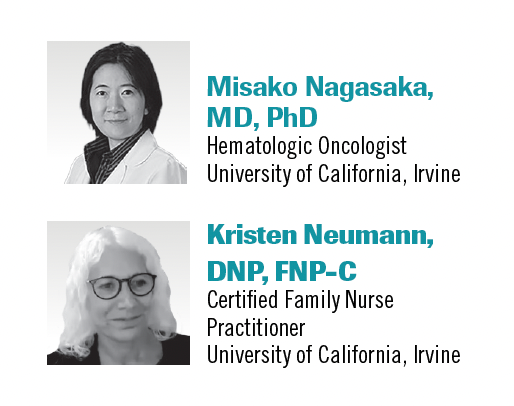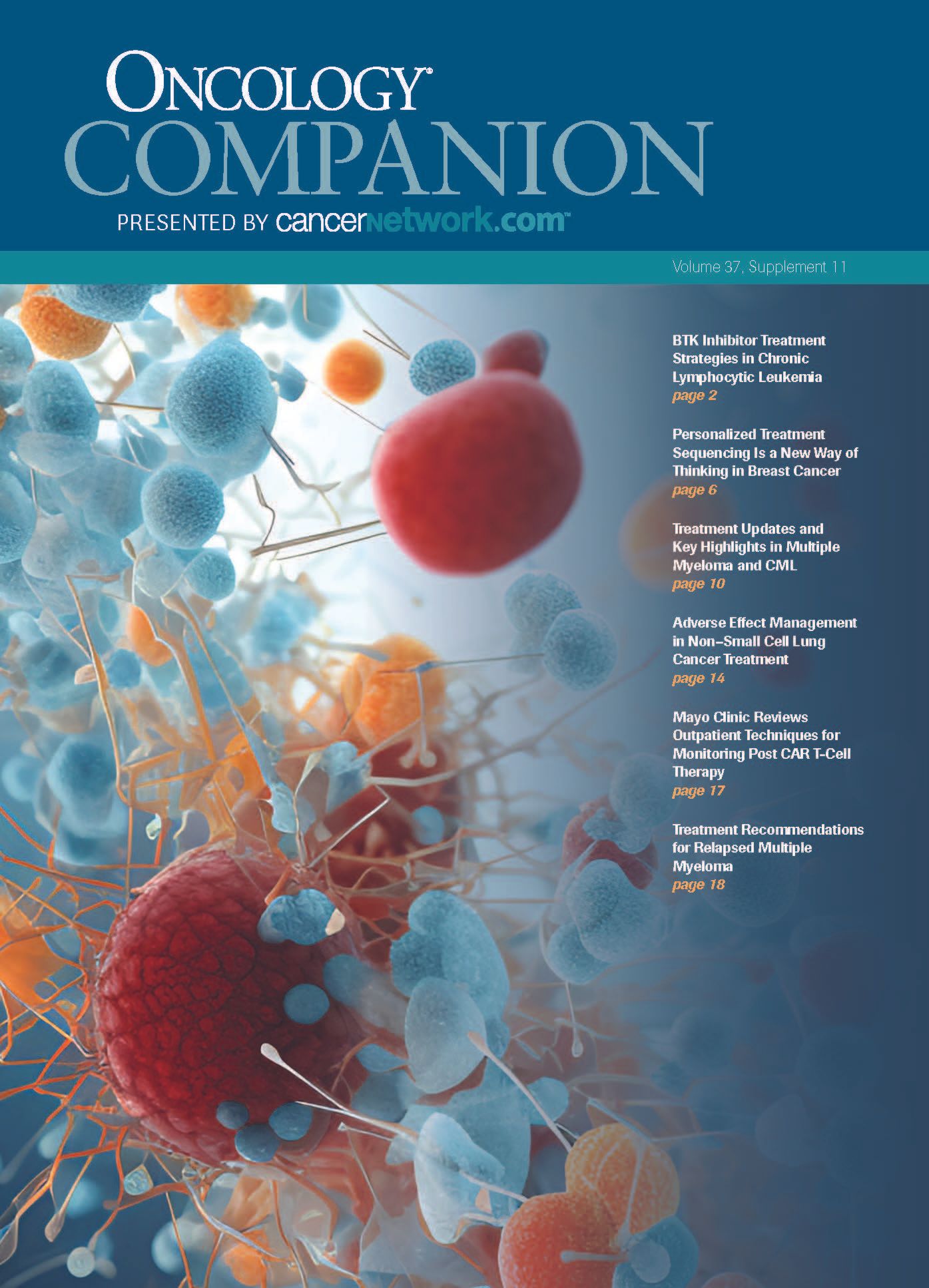Adverse Effect Management in Non–Small Cell Lung Cancer Treatment
Misako Nagasaka, MD, PhD, and Kristen Neumann, DNP, FNP-C, discussed how to best mitigate adverse effects in patients with non–small cell lung cancer.
Misako Nagasaka, MD, PhD, and Kristen Neumann, DNP, FNP-C, discussed how to best mitigate adverse effects in patients with non–small cell lung cancer.

Adverse effects (AEs) relating to osimertinib (Tagrisso) and amivantamab (Rybrevant) were discussed as part of an Around the Practice: Institutional Insights program. Misako Nagasaka, MD, PhD, and Kristen Neumann, DNP, FNP-C, met to review AEs that they encounter during treatment cycles.
Most emphasized was the need for education not only among patients but also clinicians and care teams. To best identify AEs and determine which grade they are, all parts of the team should be prepared to determine whether treatment should be halted or discontinued.
Nagasaka: What are some common AEs that might occur during treatment with osimertinib?
Neumann: The most common AE is probably No. 1 being rash, followed up very closely with No. 2 being diarrhea. The third most common one that I hear is fatigue and to a lesser degree stomach upset and nausea.
Nagasaka: Usually, these AEs don’t occur with just 1 pill, but they start to occur within the first few weeks. When I start patients on therapy, I have them come in at the 2-week mark and then another 2 weeks [after]. If all is well, I extend their visits to every 2 to 3 months and try to coincide that with their scans. How would you [treat] a patient who noticed a rash on their face?
Neumann: It’s important to start to educate [patients], even prior to the rash [appearing]. We educate them on making sure they’re using dye-free, perfume-free emollients several times a day across all body surface areas, and to make sure they get used to not spending too much time in the sun. That is difficult [because we live] in a very sun-filled state. They can wear their hats, their loose-fitting clothing, and make sure they’re using sunscreen.
Over the first couple of weeks when [the rash] starts to present itself, it depends on the grade. If it’s grade 1, I’ll have a conversation with the medical oncologist. That’s when we start the topical [treatment]; either the corticosteroids or sometimes the addition of a topical antibiotic is helpful. Continuing with those local treatments, the creams, staying out of the sun, we see how it is impacting their activities of daily living. At grade 1, it’s not too bad unless they’re having some pain, some neuritis, or some tightening [of the skin] and then trying to manage those AEs. We have a lot of things available for us to help with the pruritus, and if the patient starts to see that things are going in the direction of feeling a little bit of relief, then we can build on that and hopefully keep it where it is. If it’s just grade 1 or if it’s progressed to a grade 2, hopefully we can try to downgrade it.
Nagasaka: You mentioned diarrhea being a common AE. Do you give your patients an antiviral prior to them experiencing diarrhea?
Neumann: I will always try to educate [patients] on if there is any stomach upset or if we’re just talking about soft stools to make sure that they’re paying attention to their diet, and not eating too many foods that are hard to digest. I’ll [tell them to] cut back a little bit on the spice. At times, I also try to tell [individuals] to cut back on cow dairy products. The next step would be to prescribe loperamide [Imodium]. Typically, we start with the directions on the package insert. The first time that the person has diarrhea in the day they should take the 2 capsules and then add 1 capsule either after each time they have diarrhea after that or sometimes just every 4 hours until they are without diarrhea. [They should continue this until it becomes] soft stools or no diarrhea for 12 hours.
Nagasaka: In what circumstances do you tell the patient to stop or hold treatment?
Neumann: Usually, we start to get the multidisciplinary team involved if we’re talking about rash. Most of the literature says once you’re getting toward a grade 3 [rash to involve the team], but in our practice, we like to get our multidisciplinary team involved. [We contact them] usually at about grade 2. Once we start getting into diarrhea or some of the other AEs where we rely on patient reporting, that’s where I start to feel that we need to get them into the clinics, so that we can get a better understanding of what’s happening. Sometimes patients, if they feel as if their treatment regimen is working for them, tend to downplay some of these things that we can’t see. It is wise for all cancer centers to get the patient in, evaluate, and do some good assessment and questioning.
Nagasaka: Most of our patients, especially when the drug is working, will try to downplay their symptoms. I can see why they do that. They feel perhaps that we’re going to stop the treatment entirely or that they’re afraid of treatment being withheld. Transitioning to the use of amivantamab in treatment, what is your impression and what are some challenges when using it?
Neumann: It is quite the drug. The benefit for the community is amazing. The biggest challenge that I have seen is the skin AEs. I haven’t seen rashes like that in my experience. The good thing is that with the oncology dermatology team, we were quite prepared to see some rashes that we hadn’t seen before. We felt safe seeing the rash firsthand, knowing that the patient was going to get in to see our team within 1 to 2 days and allowing that team to direct how the management of the rash was going. Because there were very good, strong guidelines and indications to follow, I felt [comfortable] with how they were being [treated] by those professionals who had experience with managing it and knew how to manage it.
Nagasaka: Education to staff is also key because initially when amivantamab was coming out in clinical trials, the infusion nurses were very afraid to use the drug. They wanted to make sure that I was across the hallway and that my pager was working. Sometimes I had to even sit there in the infusion suite, holding my patients’ hands while they were getting their first infusion. Now I don’t have that issue anymore. I think the education for the infusion nurses has been [beneficial]. That sort of education to all staff, including the infusion nurses and the pharmacists, is key to successful treatment.
Neumann: I’m afraid that it’s not the only treatment that has the capacity for an infusion reaction. I think it’s just the learning curve. There [have] been plenty of treatments that have come down the line, particularly over the [past] 10 years or so, where the infusion center professionals do have to get used to different types of infusion reactions. But then again, once the education is there, once they know what they’re looking for, it just becomes another little card that they can pull out of their back pocket.
EP: 1.Managing Treatment-Related Rashes in Patients With EGFR-Mutated NSCLC
EP: 2.Managing Treatment-Related Diarrhea in Patients With EGFR-Mutated NSCLC
EP: 3.Implementing Dose Reductions and Dose Holds in Patients With EGFR-Mutated NSCLC Receiving TKIs
EP: 4.Multidisciplinary Management of Treatment-Related Adverse Events in Patients With EGFR-Mutated NSCLC
EP: 5.Amivantamab for Patients With NSCLC and an EGFR Exon 20 Mutation
EP: 6.Educating Patients and Clinical Staff on Infusion-Related Adverse Reactions Seen With Amivantamab in NSCLC With EGFR Exon 20 Mutations
EP: 7.Future Perspectives in the Treatment and Management of Patients With EGFR-Mutated NSCLC
EP: 8.Approaches to Biomarker Testing in Non-Small Cell Lung Cancer (NSCLC)
EP: 9.EGFR Mutations in Patients With NSCLC
EP: 10.Adverse Effect Management in Non–Small Cell Lung Cancer Treatment
EP: 11.Patient Case Presentation: A 59-Year-Old Man With EGFR-Mutant NSCLC
EP: 12.The Future of Treatment for EGFR TKI Resistance in EGFR-Mutant NSCLC
EP: 13.Multidisciplinary Care, Approval Updates, and Future Research in NSCLC
EP: 14.Treatment Approaches for Patients With EGFR-Mutant NSCLC
EP: 15.Common Adverse Events Seen With EGFR TKIs in EGFR-Mutant NSCLC
EP: 16.Approaches to Managing Patients With EGFR-Mutant NSCLC and EGFR TKI Resistance
EP: 17.Patient Case Presentation: A 69-Year-Old Man With NSCLC With EGFR Exon 20 Insertion Mutations
EP: 18.Management Strategies for Adverse Events Seen With Amivantamab in NSCLC With EGFR Exon 20 Insertion Mutations
EP: 19.The Future of Treatment for NSCLC With EGFR Exon 20 Insertion Mutations
EP: 20.Unmet Needs and Future Perspectives in NSCLC Treatment
EP: 21.New Lung Cancer Treatment Options Combine Neoadjuvant and Adjuvant Therapies
